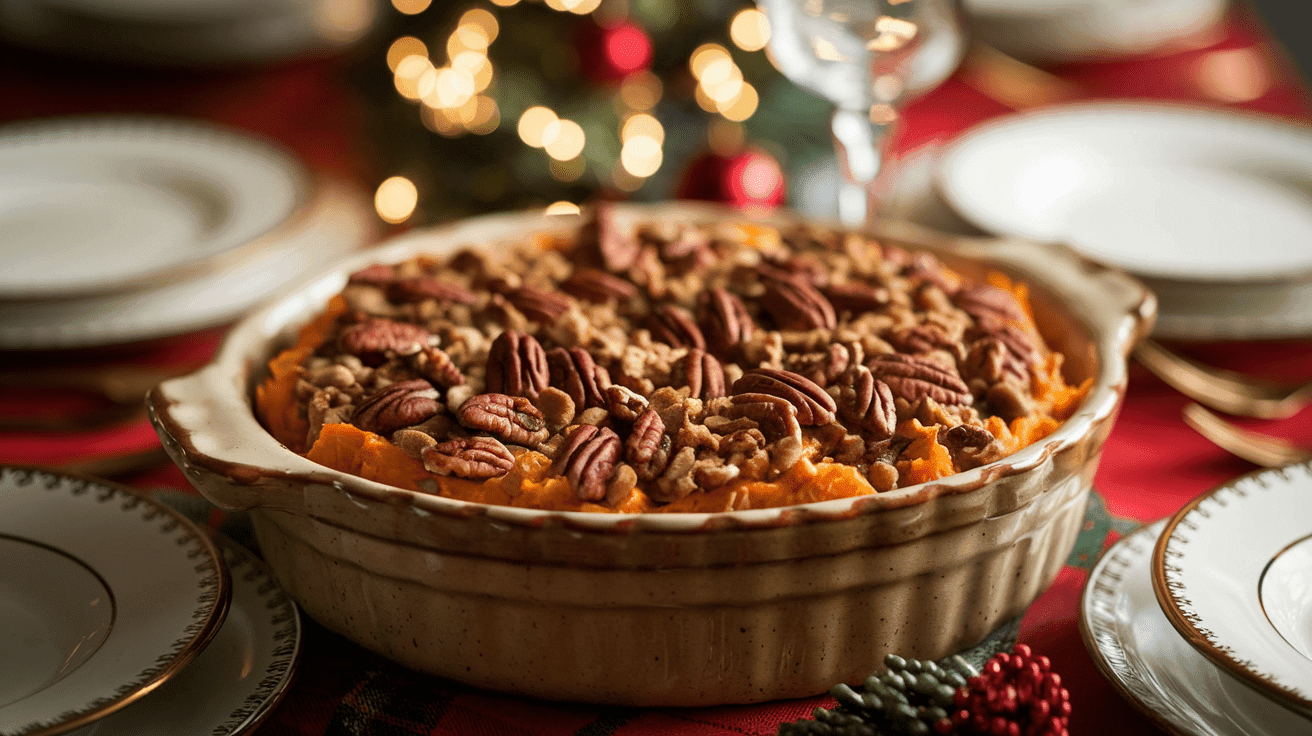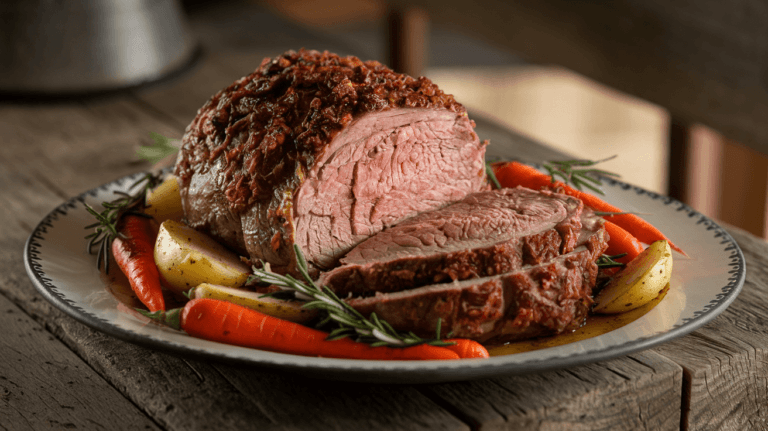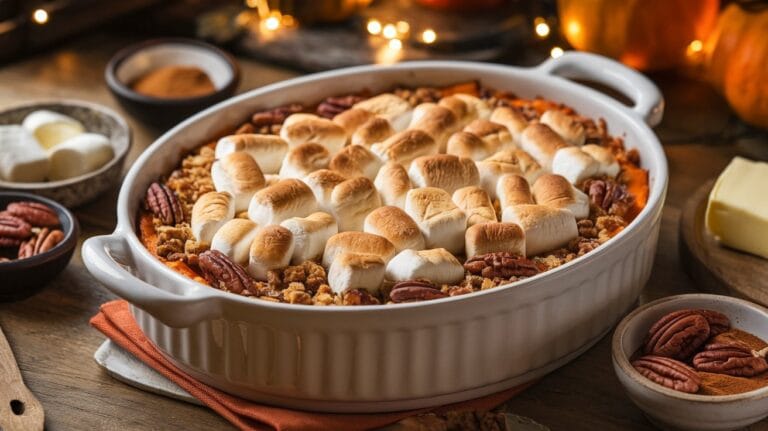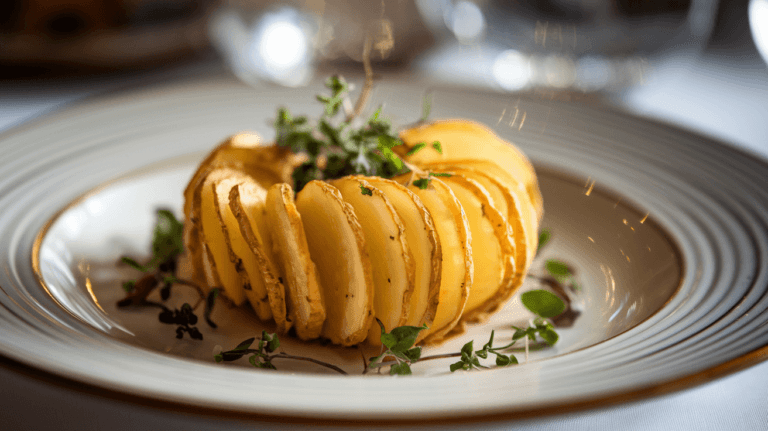Origins of This Beloved Dish
Sweet Potato Casserole Recipe has its roots deeply embedded in Southern American cuisine, where it emerged as a festive dish during the early 20th century. The combination of mashed sweet potatoes with a sweet, crunchy topping became popular during the 1917 marketing campaign by marshmallow manufacturer Angelus Marshmallows. The company’s cookbook featured the first widely published recipe for marshmallow-topped sweet potatoes, forever changing how Americans would enjoy this root vegetable.
Table of Contents
Regional Variations and Modern Adaptations
As the dish gained popularity across the United States, different regions began adding their unique twists. Some families swear by a pecan streusel topping, while others remain loyal to the classic marshmallow version. In the Midwest, you might find versions incorporating maple syrup, while Southern variations often include bourbon or pecans. Modern adaptations have embraced healthier alternatives, with some recipes featuring coconut sugar instead of brown sugar or using natural sweeteners to enhance the sweet potatoes’ inherent sweetness.
The beauty of Sweet Potato Casserole Recipe lies in its versatility. Today’s versions might include:
- A gluten-free streusel topping using almond flour
- Vegan marshmallows for plant-based diets
- Natural sweeteners like maple syrup or honey
- Added warm spices like cardamom or ginger
- Savory variations with herbs and garlic
Traditional vs. Contemporary Ingredients
The evolution of this dish reflects changing dietary preferences and culinary trends. Traditional recipes typically call for:
- Fresh sweet potatoes
- Brown sugar
- Butter
- Vanilla extract
- Eggs
- Milk or heavy cream
- Marshmallows or pecans for topping
Contemporary versions might incorporate:
- Alternative milks (almond, oat, or coconut)
- Natural sweeteners
- Plant-based butter alternatives
- Additional spices like nutmeg or cardamom
- Various nuts and seeds for texture
What makes this dish particularly special is how it bridges the gap between side dish and dessert. The sweet potato base provides essential nutrients while satisfying our craving for something sweet. Modern nutritional awareness has led to adaptations that reduce sugar content while maintaining the comforting flavors that make this dish a holiday staple.
Understanding these variations and the dish’s history helps home cooks make informed decisions about their own recipe adaptations. Whether you’re a traditionalist or an innovator, knowing the fundamental elements that make sweet potato casserole beloved helps ensure your version will be a success at any gathering.
The beauty of learning about these traditions and variations is that it empowers you to create your own signature version. Perhaps you’ll combine elements from different regional styles or incorporate a unique ingredient that becomes your family’s secret touch. After all, the best recipes are those that evolve while respecting their roots.
Ingredients for the Perfect Sweet Potato Casserole Recipe
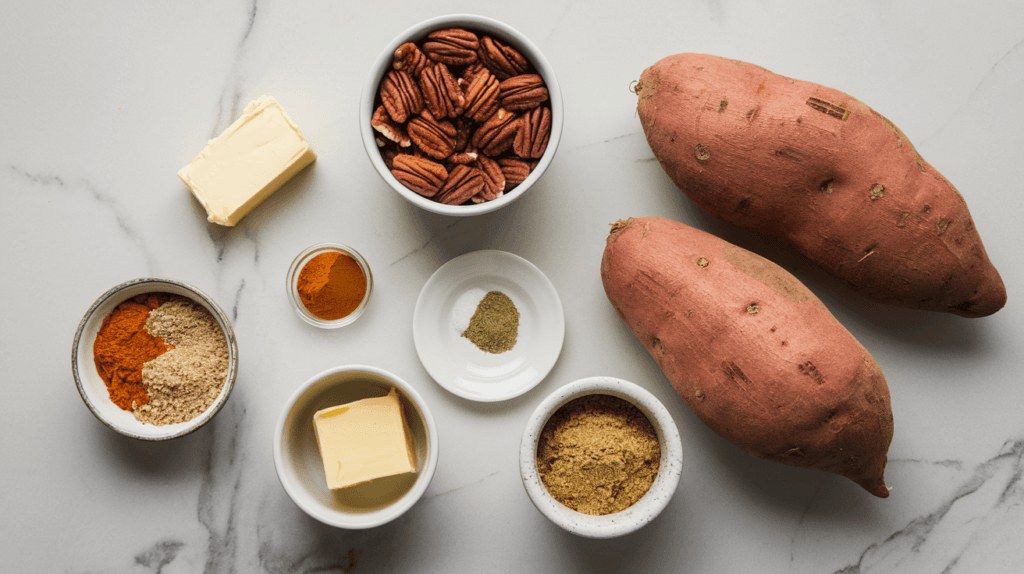
Selecting and Preparing Sweet Potato Casserole Recipe
The foundation of any outstanding sweet potato casserole begins with choosing the right sweet potatoes. Look for medium to large specimens with smooth, unblemished skin and a deep orange color. For best results, select potatoes that are similar in size to ensure even cooking time.
When preparing your sweet potatoes, you have two main cooking options:
- Baking: Wrap potatoes in foil and bake at 400°F for about an hour
- Boiling: Cut into large chunks and boil for 20-25 minutes
Both methods work well, though baking tends to concentrate the flavors and reduce moisture content. Whatever method you choose, ensure the potatoes are fork-tender before mashing. This step is crucial for achieving that perfect, creamy texture that makes this dish so irresistible.
Key Base Ingredients and Their Purpose
To transform simple mashed sweet potatoes into a luxurious casserole, you’ll need several key ingredients:
- Butter (½ cup, melted)
- Creates richness
- Enhances mouth feel
- Carries flavors throughout the dish
- Eggs (2 large)
- Provide structure
- Create a soufflé-like texture
- Help bind ingredients together
- Milk or cream (½ cup)
- Adds creaminess
- Helps achieve proper consistency
- Creates smoother texture
- Vanilla extract (1 teaspoon)
- Enhances natural sweetness
- Adds depth of flavor
- Complements the spices
Topping Options and Variations
Classic Pecan Streusel Topping
The pecan streusel topping transforms this sweet potato casserole from good to extraordinary. Here’s what you’ll need for the perfect crunchy topping:
- 1 cup chopped pecans
- ⅓ cup all-purpose flour
- ⅓ cup brown sugar
- ¼ cup melted butter
- ½ teaspoon cinnamon
Combine these ingredients until they form a crumbly mixture that will become golden and crunchy during baking. The contrast between the Sweet Potato Casserole Recipe base and the crispy topping creates an irresistible texture combination that keeps people coming back for more.
Alternative Topping Ideas
While the traditional pecan streusel is beloved, there are several other delicious options:
- Classic Marshmallow Topping
- Layer miniature marshmallows
- Broil until golden brown
- Watch carefully to prevent burning
- Mixed Nut Crumble
- Combine pecans, walnuts, and almonds
- Add oats for extra texture
- Include maple syrup for natural sweetness
- Gluten-Free Option
- Use almond flour instead of all-purpose
- Add coconut flakes for texture
- Incorporate maple syrup as binder
Step-by-Step Sweet Potato Casserole Recipe Instructions
Preparation and Base Assembly
Let’s walk through creating the perfect sweet potato casserole, starting with the essential prep work. First, preheat your oven to 375°F and grease a 9×13 inch baking dish. Next, begin with your cooked and cooled sweet potatoes – you’ll need about 4 pounds to serve 10-12 people.
- Mash the sweet potatoes until smooth
- Mix in melted butter while potatoes are still warm
- Add eggs one at a time, beating well
- Pour in milk or cream gradually
- Mix in vanilla, cinnamon, and salt
The key to achieving the perfect consistency lies in the order of ingredient addition. By incorporating the butter while the potatoes are still warm, you’ll ensure it melts evenly throughout the mixture. Additionally, adding eggs one at a time helps create a lighter, more soufflé-like texture.
Assembling and Baking Tips
After preparing your base, spread it evenly in your prepared baking dish. Here are some professional tips for the best results:
- Use a spatula to create swoops and swirls on the surface
- Leave room at the top for your chosen topping
- Tap the dish gently on the counter to remove air bubbles
- Cover edges with foil if they brown too quickly
Storage and Make-Ahead Instructions
Short-term storage:
- Cover tightly with foil
- Refrigerate for up to 4 days
- Keep topping separate if using marshmallows
Long-term storage:
- Wrap thoroughly in plastic wrap and foil
- Freeze for up to 3 months
- Label with date and reheating instructions
Make-Ahead Preparation Tips
For stress-free holiday cooking, you can prepare this dish in advance:
Two Days Before:
- Prepare and cook sweet potatoes
- Mash and mix with all ingredients except toppings
- Store base in airtight container in refrigerator
One Day Before:
- Transfer to baking dish
- Prepare topping but store separately
- Bring to room temperature before baking
- Add topping just before putting in oven
Serving Suggestions and Pairings
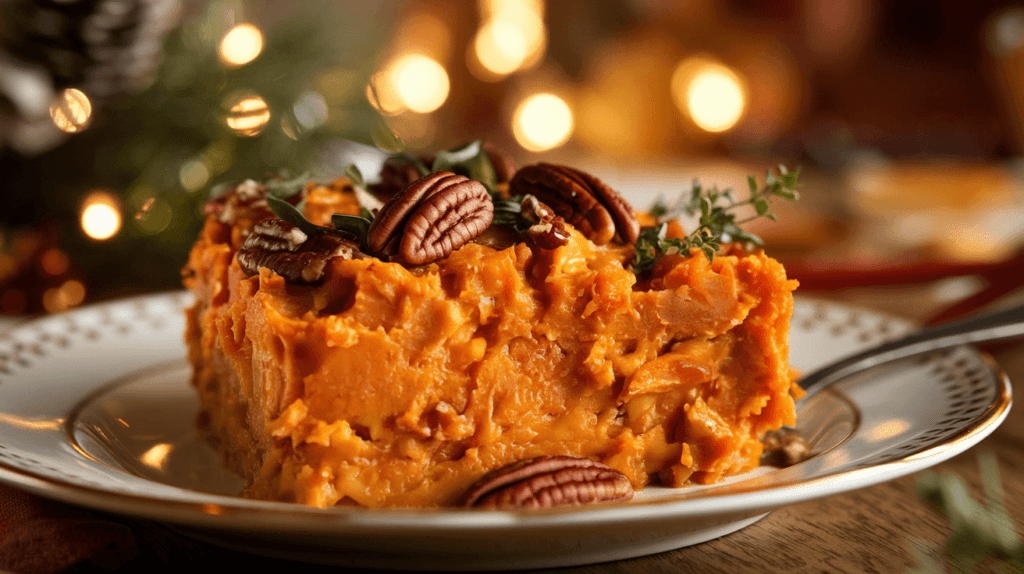
Perfect Pairings for Sweet Potato Casserole Recipe
- Roasted turkey or ham
- Green bean casserole
- Cranberry sauce
- Brussels sprouts
- Dinner rolls
The dish’s sweet and creamy nature makes it an excellent counterpoint to savory proteins and vegetables. Furthermore, its warm spices complement other holiday favorites, creating a harmonious meal experience.
Temperature and Presentation Tips
- Allow it to rest for 10-15 minutes after baking
- Garnish with:
- Fresh herb sprigs
- Extra chopped pecans
- A light dusting of cinnamon
- Keep warm by covering with foil
- Place on a trivet or decorative hot pad
Remember that presentation matters almost as much as taste. Consider serving in an attractive baking dish that can go straight from oven to table, and garnish thoughtfully to add visual appeal.
Troubleshooting Common Issues
Too Wet:
- Add more mashed sweet potatoes
- Mix in 1-2 tablespoons of flour
- Extend baking time by 10-15 minutes
Too Dry:
- Incorporate additional milk or cream gradually
- Add an extra egg
- Mix in more melted butter
Fixing Common Mistakes
- Lumpy Texture:
- Use a potato ricer for smoother results
- Pass through a fine-mesh sieve
- Beat with an electric mixer on medium speed
- Burnt Topping:
- Cover with foil during baking
- Position rack in middle of oven
- Check frequently during last 10 minutes
- Uneven Cooking:
- Cut sweet potatoes into uniform sizes
- Rotate dish halfway through baking
- Use an oven thermometer to ensure accurate temperature
If your casserole seems too sweet or not sweet enough, remember that you can adjust the sweetness next time by:
- Reducing or increasing brown sugar
- Using naturally sweeter sweet potatoes
- Adjusting the amount of vanilla extract
- Adding a pinch of salt to balance sweetness
Nutritional Information and Dietary Adaptations
A traditional sweet potato casserole serving (about 1 cup) typically contains:
- Calories: 285
- Carbohydrates: 45g
- Protein: 4g
- Fat: 12g
- Fiber: 4g
- Vitamin A: 380% DV
- Vitamin C: 15% DV
Making Your Casserole Healthier
- Base Modifications:
- Use unsweetened almond milk instead of cream
- Reduce butter by half
- Replace some butter with Greek yogurt
- Skip the eggs for a lighter texture
- Topping Alternatives:
- Use a light sprinkle of chopped nuts
- Make a reduced-sugar streusel
- Try a granola-based topping
- Use sugar-free marshmallows
Frequently Asked Questions
Common Questions About Sweet Potato Casserole Recipe
Q: Can I make sweet potato casserole ahead of time? A: Yes! You can prepare the base up to three days in advance. Store it covered in the refrigerator, but wait to add the topping until just before baking. When ready to serve, let it come to room temperature for 30 minutes before baking.
Q: How do I know when sweet potatoes are done cooking? A: Sweet potatoes are done when you can easily pierce them with a fork. The internal temperature should reach 210°F for the best mashing consistency. Additionally, the skin should easily pull away from the flesh.
Q: Can I freeze sweet potato casserole? A: Absolutely! The base freezes well for up to 3 months. However, it’s best to freeze it without the topping. When ready to use, thaw overnight in the refrigerator, add fresh topping, and bake as directed.
Q: How do I prevent my casserole from being stringy? A: To avoid stringiness, use freshly cooked sweet potatoes rather than canned ones. Moreover, mash them while they’re still hot, and use a potato ricer or food processor for the smoothest texture.
Expert Tips and Tricks
To ensure your sweet potato casserole turns out perfectly every time:
- Temperature Matters:
- Start with room temperature ingredients
- Beat eggs before adding
- Let casserole rest before serving
- Texture Tips:
- Don’t overmix after adding eggs
- Layer toppings evenly
- Watch moisture content
Remember that the success of your casserole often depends on small details like ingredient temperature and mixing technique. By paying attention to these aspects, you’ll create a dish that’s sure to become a family favorite.
If you’re looking for more tasty recipes, check out our collection of delicious meal ideas!

